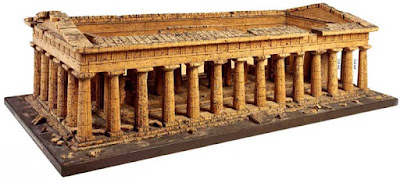Cork is harvested from Quercus suber, the Cork Oak tree, which is endemic to southwest Europe and northwest Africa. Cork is composed of suberin, a hydrophobic substance and, because of its impermeable, buoyant, elastic, and fire retardant properties, it is used in a variety of products, the most common of which is wine stoppers. And sometimes, miniature buildings. While researching another post, I discovered the Castle of Johannisburg in Germany has the world’s largest collection of cork architectural models. Entitled, “Bringing Rome across the Alps,” the display consists of 45 models of ancient Rome. These remarkably detailed reproductions were made between 1792 and 1854. They include the Colosseum, the Pantheon, the triumphal arches of the emperors Titus, Septimius Severus und Constantine, the Porta Maggiore and the Pyramid of Cestius. The architectural models were made by the court confectioner Carl May (1747-1822) and his son Georg May (1790-1853). The cork material was ideal for imitating the weathered stone surfaces of the centuries-old buildings. The Sir John Soane Museum in London also has cork building models in their collection. Even Thomas Jefferson had at least one cork replica of the great pyramid.
Sunday, April 24, 2016
Cork Souvenir Buildings & Architectural Models
Subscribe to:
Post Comments (Atom)








1 comment:
Awesome buildings - I love the cork! Mark in Toronto
Post a Comment